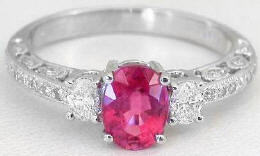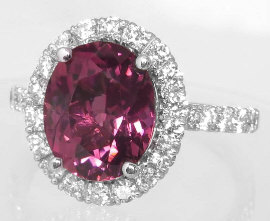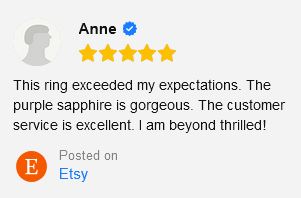|
Become an Insider & receive
up to 20% off!
|
 |
|
- -
|
Pink Tourmaline RingsPink tourmaline rings in our collection are bold, eye-catching, and designed to make a statement. With vibrant hues ranging from cranberry to rose, each ring features natural gems in luxurious settings that highlight their size, sparkle, and intensity. These distinctive designs are anything but ordinary - perfect for collectors and those with a flair for the dramatic.This page is pre-sorted from low to high price
|
  |
| 1.25 ctw Rubellite and White Sapphire Ring in 14k white gold |
Ships in 2-3 weeks GR-9184-WS$1019 |
  |
| 0.85 carat Sleek Rubellite Tourmaline Ring in 14k white gold |
In Stock GR-9033$1519 |
  |
| 1.23 ctw Rubellite Tourmaline and Diamond Ring in 14k white gold |
Ships in 2-3 weeks GR-9184$1509 Special Order |
  |
| 1.41 ctw Rubellite Tourmaline and Diamond Ring in 14k white gold |
Ships in 1-3 weeks GR-9141$2119 |
  |
| 1.26 ctw Pink Tourmaline and Diamond Ring in 14k white gold |
In Stock GR-9166$2419 |
  |
| 1.57 ctw Pink Tourmaline and Diamond Ring in 14k white gold |
In Stock GR-9170$2489 |
  |
| 5.07 carat Nigerian Pink Rose Tourmaline Leaf Design Ring in 14k yellow gold |
In Stock GR-9129-PR$2669 |
  |
| 2.09 ctw Pink Tourmaline and Diamond Ring in 14k yellow gold |
In Stock GR-9108$2889 |
| Customer Testimonial more... |
I received the pink tourmaline ring that I ordered and boy are we pleased. The stone was quite impressive and is much better quality than any we have seen locally. Thanks. O.M., Savannah, GA |
  |
| 5.6 ctw Nigerian Pink Rose Tourmaline Leaf Design Ring in 14k white gold |
In Stock GR-9130-PR$2909 |
  |
| 5.85 carat Nigerian Cranberry Rose Pink Tourmaline Leaf Design Ring in 14k yellow gold |
In Stock GR-9129-CR$2929 |
  |
| 1.66 ctw Pink Tourmaline and Diamond Ring in 14k white gold |
In Stock GR-9133$3599 |
  |
| 2.66 ctw Buff Top Pink Tourmaline and Diamond Ring in 14k rose gold |
Ships in 3-4 weeks GR-9168$3679 Special Order |
  |
| 6.0 ctw Nigerian Cranberry Rose Pink Tourmaline Leaf Design Ring in 14k white gold |
In Stock GR-9130-CR$3659 |
  |
| 6.63 carat Nigerian Salmon Rose Pink Tourmaline Leaf Design Ring in 14k rose gold |
In Stock GR-9205$3939 |
  |
| 2.8 carat Pink Tourmaline Tank Ring in 14k white gold |
In Stock GR-9093$4169 |
  |
| 2.8 carat Pink Tourmaline Tank Ring in 14k yellow gold |
In Stock GR-9086$4169 |
  |
| 4.66 ctw Oval Pink Tourmaline and Diamond Ring in 14k white gold |
Ships in 2-3 weeks GR-9202$3959 Special Order |
  |
| 2.03 ctw Rubellite Tourmaline and Diamond Ring in 14k white gold |
In Stock GR-9123$4139 |
  |
| 3.30 ctw Princess Cut Pink Tourmaline and Diamond Ring in 14k white gold |
Ships in 2-3 weeks GR-9193$4269 Special Order |
  |
| 2.90 ctw Cushion Cut Pink Tourmaline and Diamond Ring in 14k yellow gold |
Ships in 2-3 weeks GR-9200$4399 Special Order |
  |
| 2.90 ctw Cushion Cut Pink Tourmaline and Diamond Ring in 14k white gold |
Ships in 2-3 weeks GR-9189$4399 Special Order |
  |
| 6.0 ct Semi-bezel set Nigerian Salmon Tourmaline Diamond Ring in 14k yellow gold |
In Stock GR-9046-1$4949 |
  |
| 5.0 ct Semi-bezel set Nigerian Tourmaline Diamond Ring in 14k white gold |
In Stock GR-9046-2$4979 |
  |
| 4.18 ctw Pink Tourmaline and Diamond Ring in 14k white gold |
Ships in 2-3 weeks GR-9132$5239 Special Order |
  |
| 4.01 ctw Pink Tourmaline and Diamond Ring in 14k white gold |
Ships in 2-4 weeks GR-9128$5399 Special Order |
  |
| 5.59 ctw Pink Tourmaline and Diamond Ring in 14k yellow gold |
In Stock GR-9116$5549 |
  |
| 6.04 ctw Pink Tourmaline and Diamond Ring in 14k white gold |
Ships in 1-3 weeks GR-9187$5829 |
  |
| 5.73 ctw Pink Tourmaline and Diamond Ring in 14k white gold |
Ships in 2-3 weeks GR-9183$6029 Special Order |
  |
| 7.04 ctw Pink Tourmaline and Rainbow Sapphire Ring in 14k white gold |
In Stock GR-9151$7339 |
  |
| 6.27 ctw Round Pink Tourmaline and Diamond Ring in 14k white gold |
In Stock GR-9186$7549 |
  |
| 6.78 ctw Pink Tourmaline and Rainbow Sapphire Ring in 14k yellow gold |
In Stock GR-9135$8059 |
  |
| 8.53 ctw Pink Tourmaline and Diamond Ring in 18k white gold |
In Stock GR-9177$11649 |
  |
| 11.34 ctw Pink Tourmaline and Diamond Ring in 14k white gold |
In Stock GR-9150$11619 |
|
Precious Rings: Blue Sapphire | Pink Sapphire | Rainbow Sapphire | Yellow Sapphire | Orange
Sapphire | Fancy | Ruby | Emerald
Other Gems: Multi-gemstone | Amethyst | Aquamarine | Blue Topaz | Blue Zircon | Citrine | Garnet | Iolite | Pearl | Peridot |
| Fun Fact: In the realm of gemstone lore, pink tourmaline is steeped in mystery and revered for its metaphysical properties. Many believe that wearing pink tourmaline can help dispel negative energy, promote emotional resilience, and even enhance one's intuitive abilities. This enchanting reputation as a protective and spiritually uplifting gem makes it more than just a decorative stone - it becomes a personal emblem of hope and renewal. |
Tourmaline In the NewsThe latest developments in the world of gemstones and jewelry Last Update: July 23, 2025Tourmaline Stone Buying Guide & Tourmaline MeaningSummary: The article provides a comprehensive guide to buying tourmaline gemstones, discussing their meaning and significance. It covers different types of tourmaline such as watermelon tourmaline and paraiba tourmaline, offering insights into their colors, properties, and market value. This guide is valuable for jewelry professionals and enthusiasts looking to understand the characteristics and market trends of tourmaline gemstones.
Read More (opens in new window)
|
Tourmaline in the News
Tourmaline In the News
The latest developments in the world of gemstones and jewelry
Last Update: July 23, 2025Tourmaline Stone Buying Guide & Tourmaline Meaning
What is tourmaline and how is it formed?
Tourmaline is a naturally occurring mineral and belongs to a complex group of boron silicates that form deep within the Earths crust. It develops in environments rich in hot fluids and gases, typically within granite pegmatites and metamorphic rocks. As these fluids cool and crystallize, they give rise to tourmaline crystals that grow slowly over millions of years. The presence of various trace elements, such as iron, manganese, lithium, and chromium, during formation determines the final color of each stone, which is why tourmaline comes in such an extraordinary range of hues.
What makes tourmaline especially fascinating is that no other gemstone family offers the same diversity of colors within a single mineral group. It can appear in nearly every shade, from electric blues to deep greens, blush pinks, sunny yellows, and even bi-color or tri-color combinations. Some crystals display natural color zoning, while others are remarkably uniform. Because tourmaline forms in such a variety of geological environments, it is found in many regions around the world including Brazil, Afghanistan, Mozambique, Nigeria, and the United States. Each origin may yield slightly different colors or crystal habits. This vast range of expression is one reason why tourmaline is cherished by both collectors and jewelry lovers.
Is tourmaline a good choice for everyday wear jewelry?
Tourmaline is an excellent gemstone for everyday wear, offering an appealing balance between beauty, durability, and affordability. It has a hardness rating of 7 to 7.5 on the Mohs scale, which provides good resistance to surface scratching. While it is not as hard as sapphires or diamonds, it is more than suitable for rings, earrings, and pendants that are worn regularly. Many people successfully wear tourmaline engagement rings or signature pieces for years with just basic care.
In terms of toughness, tourmaline is generally stable and resistant to breakage under normal wear conditions, although sharp impacts should still be avoided. One of the great advantages of tourmaline is the variety of shapes and cuts it can be found in, from classic rounds and ovals to elongated emerald cuts or unique cabochons. This versatility allows for creative, personalized designs. Tourmaline also takes a high polish, which enhances its natural brilliance and gives it a refined appearance in finished jewelry. To keep your tourmaline jewelry looking its best, avoid ultrasonic cleaners and clean regularly using mild soap, warm water, and a soft cloth or brush.
What determines the value of a tourmaline?
Several key factors influence the value of a tourmaline, with color being the most important. The most prized tourmalines display vivid, saturated hues that are neither too dark nor too light. Whether its a hot pink, a neon green-blue Paraiba, or a rich forest green, a pure and lively color will command a premium. Stones that appear dull, overly gray, or have uneven color distribution are typically less valuable. Some colors, like chrome green and Paraiba blue, are significantly rarer and fetch higher prices regardless of size.
Clarity is an important factor in evaluating tourmaline and its helpful to know that tourmaline is classified as both a Type II (green) and a Type III (pink) gemstone. A Type II gemstone is generally expected to be eye clean and a Type III gemstone will typically have some inclusions. Fine pink tourmalines that are eye clean, showing no visible inclusions to the unaided eye, are the exception rather than the rule. While minor inclusions are acceptable, especially in certain color types, high-quality tourmalines should be eye clean, with no visible internal flaws that distract from the stones beauty. At MyJewelrySource, we offer a curated selection of pink tourmalines that stand out not only for their clarity but also for their vibrant color and substantial size. Many of our pink tourmaline rings feature gems that are not only beautifully cut and lively but also unusually clean for this type of stone, making them a distinctive and valuable choice for those seeking a truly special piece.
Cut also plays a major role, as a well-proportioned cut maximizes brilliance, enhances color, and masks any small inclusions. Poorly cut stones can appear dark or lifeless even if the material is otherwise good. Carat weight affects value too, with larger stones exponentially more rare, especially when paired with excellent color and clarity.
Origin can sometimes influence price, particularly for rare material like Brazilian Paraiba or Afghan pinks, though visual quality will usually matter more to buyers than source. Ultimately, the finest tourmalines are those that combine beauty, rarity, and good craftsmanship. While tourmaline is still more affordable than some other gemstones, exceptional examples can be quite valuable and collectible.
Are all pink tourmalines natural in color or are some enhanced?
Many pink tourmalines on the market today have undergone low-temperature heat treatment to improve their color, especially lighter stones that may have gray or brownish modifiers in their natural state. Heating can help brighten the pink or remove undesirable tones, and the treatment is stable and widely accepted in the industry. However, it is not always disclosed, and not all gem material requires it.
That said, not every pink tourmaline is treated. Some naturally form with beautiful, vivid color and need no enhancement at all. At MyJewelrySource.com, we source many of our pink tourmalines from Nigeria, a region known for producing rich pink gems that do not require heating. We specifically seek out stones with naturally vibrant color, excellent clarity, and strong visual appeal without relying on treatments. This ensures that you are getting a gem with lasting, natural beauty and a level of quality that stands apart from more commercial-grade offerings.
Why do some pink tourmalines look more bubblegum pink while others are pale or dusty rose?
Pink tourmaline occurs in a broad range of shades, from soft blush and rosy beige to bright bubblegum and fuchsia. These color differences are primarily caused by the varying levels of manganese in the crystal structure. Stones with higher concentrations of manganese tend to show more vivid, saturated pinks, while lower levels produce lighter or more muted tones.
Other factors can also influence how the color appears. The cut of the stone affects how light interacts with the gem, which can make a pink appear brighter or deeper. Lighting conditions also play a role, with some stones appearing cooler or warmer depending on whether youre viewing them in daylight or incandescent light. No matter the shade, whats most important is choosing a pink tourmaline that speaks to your personal preference. At MyJewelrySource, we offer a range of pink tones, carefully chosen for their beauty, vibrancy, and clarity.










